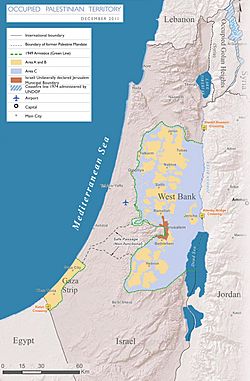Israeli–Palestinian conflict facts for kids
Quick facts for kids Israeli–Palestinian conflict |
|||||||||
|---|---|---|---|---|---|---|---|---|---|
| Part of the Arab–Israeli conflict | |||||||||
 Map of Israel and Palestine, showing zones of control as outlined by the Oslo Accords |
|||||||||
|
|||||||||
| Belligerents | |||||||||
Governance (PNA): |
|||||||||
|
Supported by:
Former support:
|
Supported by:
Former support:
|
||||||||
| Casualties and losses | |||||||||
| 21,500+ casualties (1965–2013) | |||||||||
The Israeli–Palestinian conflict is one of the world's most enduring conflicts, beginning in the mid-20th century. It is a war and dispute that is going on between the State of Israel and the Palestinians (some of which are represented by the Palestinian Authority, Fatah, or Hamas). The dispute is over a specific area of land (what used to be the Mandatory Palestine area) that Palestinians and Israelis both claim.
Contents
History
At the end of the 19th century, the idea to make Palestine "a national home for the Jewish people" began to circulate. This created tensions. After World War I, the British government that controlled the Palestinian territory at that time was obliged to do so, according to the Mandate for Palestine. Many Palestinians did not agree to that. Tensions grew into open sectarian conflict between Jews and Arabs.
On 29 November 1947, the General Assembly of the United Nations adopted Resolution 181(II). It recommended to divide Palestine into an Arab state, a Jewish state and the City of Jerusalem.On the next day, Palestine was swept by violence. The 1947–1949 Palestine War began, leading to around 15,000 casualties.
The Israelites occupied some of the Palestinian territories in the 1967 Six-Day War.
The latest round of peace negotiations began in July 2013 but were suspended in 2014. Since 2006, Hamas and Israel have fought five wars, the most recent in 2023.
Public opinion
A minority of Jewish Israelis (32 per cent) support a two-state solution with the Palestinians. Many Israeli Jews favor maintaining the status quo.
Approximately 60 per cent of Palestinians (77% in the Gaza Strip and 46% in the West Bank), support armed attacks against Israelis within Israel as a means of ending the occupation, while 70% believe that a two-state solution is no longer practical or possible as a result of the expansion of Israeli settlements. More than two-thirds of Israeli Jews say that if the West Bank was annexed by Israel, Palestinians resident there should not be permitted to vote.
Fatalities
The conflict's casualties have not been restricted to combatants, with a large number of civilian fatalities on both sides.
According to the Stockholm International Peace Research Institute, 13,000 Israelis and Palestinians were killed in conflict with each other between 1948 and 1997. Other estimations give 14,500 killed between 1948 and 2009.
Peace process
Many attempts have been made to make a two-state solution, which would mean an independent Palestinian state and an Israeli state, dividing the land between the two groups. However, public support for a two-state solution, which formerly enjoyed support from both Israeli Jews and Palestinians, has dwindled in recent years.
Progress was made with the Oslo Accords of 1993–1995.
International efforts
The violence of the conflict in the region has been the subject of numerous international conferences dealing with historic rights, security issues, and human rights. The region is rich in sites of historic, cultural, and religious interest worldwide, so violence has been a factor hampering tourism.
The United Nations provides humanitarian help for Palestinian refugees and monitors the situation in the region.
Images for kids
-
The Palestinian Arab Christian-owned Falastin newspaper featuring a caricature on its 18 June 1936 edition showing Zionism as a crocodile under the protection of a British officer telling Palestinian Arabs: "don't be afraid!!! I will swallow you peacefully...".
-
The Arab revolt of 1936–1939 in Palestine, motivated by opposition to mass Jewish immigration.
-
Yitzhak Rabin, Bill Clinton, and Yasser Arafat during the Oslo Accords on 13 September 1993.
-
Israeli settlers in Hebron, West Bank
-
Greater Jerusalem, May 2006. CIA remote sensing map showing what the CIA regards as settlements, plus refugee camps, fences, and walls
-
Home in Balata refugee camp demolished during the second Intifada, 2002
-
A neighbourhood in Ariel, home to the Ariel University
See also
 In Spanish: Conflicto israelí-palestino para niños
In Spanish: Conflicto israelí-palestino para niños
















